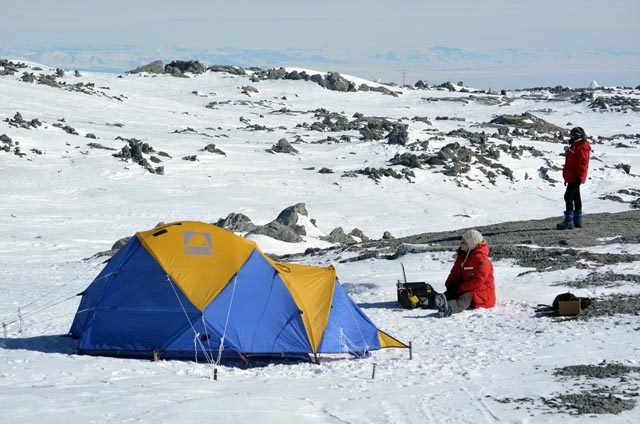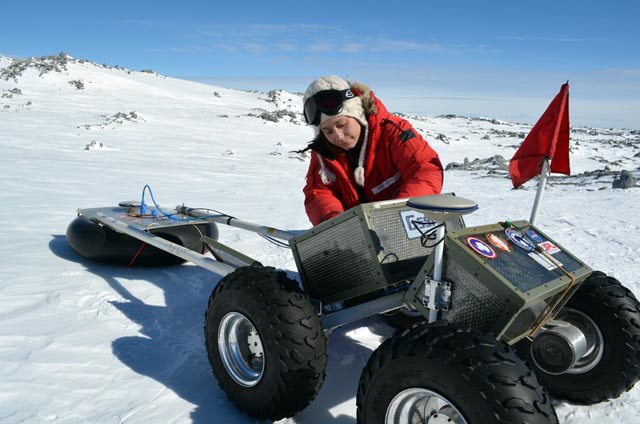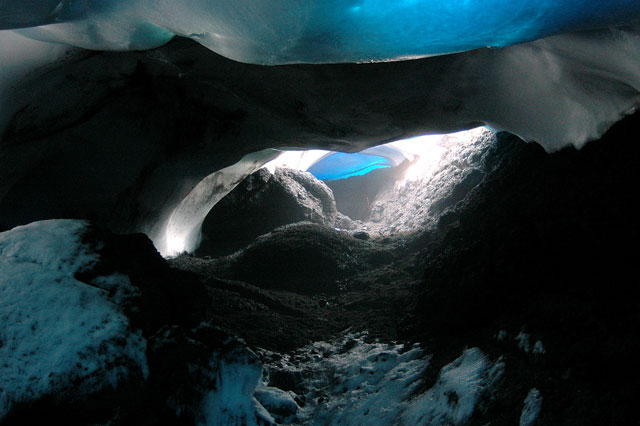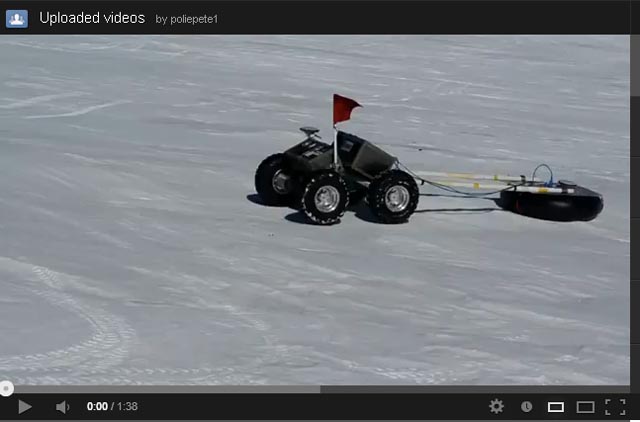|
Page 2/2 - Posted March 1, 2013
Yeti offers noninvasive way to explore volcanic ice cavesYeti’s noninvasive radar scans of the ice caves offer an alternative way to study the structures without risking their possible biological values. “We have a general idea of where caves might be. This is a noninvasive way of finding new caves,” notes Drea Rae Killingsworth, a graduate student at New Mexico Tech under Kyle. Killingsworth has spent the last two summer seasons using LIDAR to make high-resolution maps of both the interior and exterior of several Erebus ice caves. The technique measures the morphology of the ice and rock by analyzing the backscattered light from the laser. 
Photo Credit: Peter Rejcek
Engineer Rebecca Williams, left, and scientist Drea Rae Killingsworth watch Yeti (not pictured) as it manuevers around the slopes of Erebus.
The scans can reveal how the caves change from year-to-year, she explains. “There are rooms that collapse. The [entrances] can change drastically year from year,” says Killingsworth, a former pastry chef who owned a restaurant before returning to school to work in geology and volcanology. (A pile of rich chocolate-chip cookies in the team’s main field camp building attests that she hasn’t entirely abandoned her former craft.) Killingsworth notes that the Yeti project on Erebus is truly collaborative. The volcanologists learn more about the ice cave structure and extent, while Williams and her colleagues at Dartmouth can validate their programming and data collection for the robot. “There aren’t many places where you can do GPR and then go underneath and look to see if you’re right,” says Killingsworth, who is helping Williams run her surface surveys with Yeti over the well-known Warren Cave on a rare cloud-free morning. “For us, she can look at caves that we can’t get into. … We could be missing more than 50 percent of the cave just because we can’t access it.” Williams agrees. “We have so much data. It’s really kind of rare that you get some much ground truth, so much redundancy, that you can check all of your measurements with.” Yeti’s simplicity is part of its strength. It only requires six lightweight lithium batteries. The military-grade batteries provide 48 volts, enough to keep the robot rolling for several hours at a time. A radio antenna receives instructions from Williams’ laptop, which she can use to manually drive Yeti using the arrow keys. The rover is also capable of working automatously using pre-programmed routes. It took about a day to program the robot for its mission to ensure it avoided the thinnest sections of the ice cave roof — about 10 centimeters thick. The humans accompanying Yeti on its survey stay to the marked perimeters. “We were worried about Yeti, because we were wondering how we’d get him back if he fell in a hole,” Killingsworth says. “It’s always beautiful and fun out here, but there are always interesting challenges to try and get what you need to get done, done.” Yeti seems unperturbed by all the fuss, as it rolls across the bumpy snow surface. No falls. No spin-outs in deep snow. The rover drives along at a few kilometers per hour, occasionally stopping, and then backing up before it begins a new scan of the surface. “You can make such tight survey lines with Yeti that you can get really close spacing of the data and reconstruct it three-dimensionally,” says Williams, whose thesis work has involved creating an algorithm to enable Yeti to analyze and react to the data it collects in real time. Currently, such analysis still requires a human being. [See previous article — Keep on truckin': South Pole Traverse adds second train, tests robotic tractors.] For Kyle, who has overseen the Mount Erebus Volcano Observatory “Erebus is just a fabulous model for [studying] volcanoes,” Kyle says. NSF-funded research in this story: Philip Kyle and Clive Oppenheimer, New Mexico Tech, Award No. 1142083 |



For USAP Participants |
For The Public |
For Researchers and EducatorsContact UsU.S. National Science FoundationOffice of Polar Programs Geosciences Directorate 2415 Eisenhower Avenue, Suite W7100 Alexandria, VA 22314 Sign up for the NSF Office of Polar Programs newsletter and events. Feedback Form |




